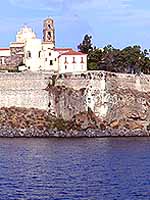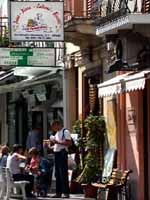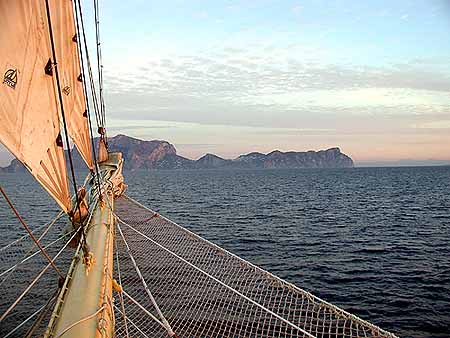19 September, Wednesday: Island of Lipari
The red lava base of the island rises to a plateau crowned with a 16th century castle and a 17th century cathedral. Like most cathedrals, the vaulted ceilings of the Cattedrale di San Bartolomeo are painted with various biblical scenes. But there was one scene that I had never seen before: a woman about to hit a man on the head with a claw hammer. Now, women bopping men on the head isn't unusual in biblical stories; they had reason enough most of the time. But, a claw hammer? That was new. And nobody I asked knew what particular story the painting depicted. C'est bizarre! Across from the cathedral is an archaeological park and excavations of buildings going back 3500 years.
Lipari is a typical coastal island town with narrow streets and steps climbing steep hills. We walked up and down, getting our exercise and photographs. Had pizza for lunch, something I really enjoyed. Al encountered a British lady at a news stand who was loudly demanding her newspaper immediately, even before it was unpacked from the hand truck. When Al suggested patience, she called him "stroppy." I was shocked. I had no idea I had been traveling with a stroppy person. Would others notice?
The Star Clipper set sail early that afternoon, about 2:00. Passengers who wanted to photograph the ship from the sea were invited to board a "photo tender." Two of the tenders circled the ship for about twenty minutes, affording great views of the ship with all her sails unfurled.
| The Active Volcano Stromboli | Lipari |

|

|
| The Port of Lipari | Street Scene |

|

|
| A Green Shade | Mercato |

|

|
| Frutta e... | ...verdura |

|

|
| Italian Ceramics | Conquistatori Puppets |

|

|

